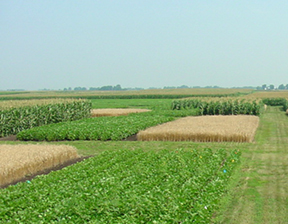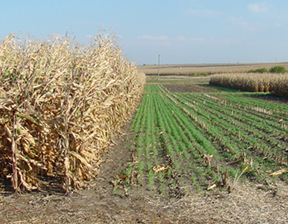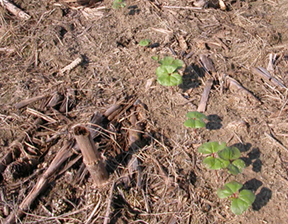Crop Rotations for Row Crops
Contributors:
Jeremy Singer, Agricultural Research Service, Ames, IA
Phil Bauer, Agricultural Research Service, Florence, SC
Last modified - June 11, 2009
Introduction
What is crop rotation?
Crop rotation is a “system of growing different kinds of crops in recurrent succession on the same land” (Martin, Leonard, and Stamp, Principles of Field Crop Production, 1976). Thus, in the strictest sense, crop rotation is more than just changing crops from year to year based on current economic situations. Rather, it is a long-term plan for soil and farm management. The photo at right shows three crops in a corn-soybean-wheat/red clover rotation.
Why use crop rotation?
At the farm management level, crop rotations are used to diversify income, spread labor requirements throughout the year, and spread the crop loss risk associated with weather and pests across two or more crops. Rotations are also used to increase crop productivity by enhancing soil quality. In terms of soil management, crop rotations are used to:
- Manage weed, insect, and disease pests
- Reduce soil erosion by wind and water
- Maintain or increase soil organic matter
- Provide biologically fixed N when legumes are used in the rotation
- Manage excess nutrients
The above factors all serve to increase crop yields, but there often is a yield increase to rotation above what can be accounted for by these factors. This response is called the “rotation effect” and has been documented for a variety of crops across multiple climates. The specific mechanism(s) causing this response has not been identified. Results from numerous studies in Corn Belt states indicate corn yield is about 10-15% higher in corn grown following soybean than corn grown following corn. Similarly, soybean yields following corn are typically 10-15% higher than when soybean follows soybean. Studies comparing the economics of crop rotation almost always conclude that profitability is enhanced by rotating crops. Duffy (2008) estimates that corn following soybean will cost 14% less per bushel to produce in 2009 than corn following corn. Producers using crop rotation will likely increase their profitability and promote the multifunctional benefits of crop diversity. Benefits to the ecosystem (soil quality, water quality) will likely increase as crop rotations are extended.
Why doesn't everybody use crop rotation?
Crop rotation was widely used prior to the development of mechanization, synthetic nutrient sources, and pesticides. Crop diversification was used to provide a diverse source of food for families, feed for draft, meat, and milk animals, sources of nitrogen for subsequent crops, to break weed, disease, and insect cycles, and as an overall risk management tool. These basic ecological principles still apply today, although advances in technology and marketing have contributed to shorter or no crop rotations and more specialized agricultural systems.
Decisions about planting crops are complex. Crop price fluctuation, input costs, rental agreements, government price supports, weather, choice of farming system and on-farm resources such as animal manures, and other factors all contribute to decisions about crop rotations. Market conditions can have a dramatic effect on crop rotation. An example of this was the national corn acreage in 2007, which experienced an unprecedented 19.5% increase compared to 2006 because of increased demand for corn grain for ethanol production. This increase in corn acreage in 2007 shifted a significant portion of the total corn acreage to second year corn. Continuous corn or corn after corn is also still grown on many dairy farms that have a large demand for corn silage and want to utilize manure derived nutrients more efficiently. This same trend is also evident in the upper Midwest dairy systems. This example illustrates the conflict between the known benefits of crop rotation and the specific corn silage inputs used for formulating dairy rations.
In the photo at right, a rye cover crop was planted after corn silage to protect the soil from erosion; corn grain on the
left of the photo has not yet been harvested.
increase compared to 2006 because of increased demand for corn grain for ethanol production. This increase in corn acreage in 2007 shifted a significant portion of the total corn acreage to second year corn. Continuous corn or corn after corn is also still grown on many dairy farms that have a large demand for corn silage and want to utilize manure derived nutrients more efficiently. This same trend is also evident in the upper Midwest dairy systems. This example illustrates the conflict between the known benefits of crop rotation and the specific corn silage inputs used for formulating dairy rations.
In the photo at right, a rye cover crop was planted after corn silage to protect the soil from erosion; corn grain on the
left of the photo has not yet been harvested.
Background
How is soil affected?
The extent that soil is affected by crop rotation depends on diversity of crop species grown in the rotation and the length of the rotation. A well-planned rotation will include crops that address the specific needs of the soil in the field or farm. Because there are so many possible rotations with many different crops and cropping practices, it is impossible to summarize all possible ways soil is affected.
Rotations that include alternating susceptible and resistant crops to specific nematodes, diseases, or soil insects can keep populations of the pests at levels that do not significantly reduce yield. Many crop rotations are based on managing pests for the highest economic value crop in the rotation.
The number and kind of weed seeds in the soil is also influenced by rotations. By rotating crops and herbicide chemistry, there is a lower chance of allowing populations of specific weeds to increase. Including meadow crops that are harvested as hay or silage in the rotation can significantly reduce weed seeds in the soil that are pests in annual crops such as corn, cotton, and soybean.
Rotations that include cash and meadow crops such as legumes or perennial grasses can add considerable organic matter to the soil by decomposition of above and below ground plant material, especially meadow crop roots. These roots maintain or increase soil humus (long-lasting organic matter). Organic matter content influences soil bulk density (a measure of compaction), soil water holding capacity, cation exchange capacity, soil aggregation, and nutrient availability. Rotations including high residue cash crops (e.g. corn or small grains) or cover crops (e.g. clover or cereal rye), when used in conservation tillage systems, can increase soil water (by increasing rainfall/irrigation infiltration and reducing soil water evaporation) and keep soils cooler. Rotations that increase soil organic matter increase beneficial bacteria and fungi populations in the soil. Rotations that include sod phases can almost eliminate soil erosion during the sod phase of the rotation.
Rotations with legumes (e.g. alfalfa) reduce the need for nitrogen fertilizer for subsequent non-legume crops. Rotations with these crops often can improve soil properties through enhanced soil microbiological activity. Legume cover crops (e.g. hairy vetch) add nitrogen to the soil and reduce the nitrogen fertilizer requirements of subsequent crops. Cover crops also protect the soil from erosion during periods when the land would lay fallow. Rotations with cover crops that are not legumes can scavenge residual nitrogen, keeping it from being lost to surrounding ecosystems.
How to monitor the soil
The Soil Quality Test Kit provides several ways to assess some of the beneficial effects of crop rotations for row crops.
Local considerations
Region-specific data:
Regional rotations have evolved in response to climate, soils, and the proximity to markets. Rotations with meadows are generally confined to farms that have ruminant animals to consume the forage or have a market for the forage. Specific crop rotations typically evolve in concert with changes in the larger farming system in the region. The following are examples of typical rotations of agronomic crops for different regions of the country.
Much of the northeast US agriculture is dominated by dairy production. Consequently, rotations including corn silage and meadow dominate this region. In recent years, soybean acreage has increased as oat production declined. A common rotation in the region now might include corn-soybean for grain crop producers and the inclusion of meadow for producers still raising ruminants.
Rotations in the humid southeastern United States are used for pest management (primarily weeds and soil-borne diseases and nematodes), for building soil organic matter, and for protecting soil from erosion. For cash crops, rotations are often planned around the crop with the highest economic return in a specific area. This is especially so when pest management is a primary reason for the rotation. For example, in some areas of the southeast, peanut often provide the highest profits for growers. However, peanut cannot be grown  every year on the same land because of plant diseases, and should not be grown following other legumes. Therefore, common rotations include a three- or four-year rotation that includes cotton and corn. In areas of the Southeast with long growing seasons, crop rotations can occur within one year. A common one-year rotation in the southeast is a double-crop system where wheat is grown during the winter and soybean is grown during the summer. Vast acreages of this rotation are grown throughout the Atlantic Coastal Plain and Piedmont regions. Similarly, a two-year, three-crop rotation is used that includes a wheat-soybean double-crop followed by corn or cotton in the second year.
every year on the same land because of plant diseases, and should not be grown following other legumes. Therefore, common rotations include a three- or four-year rotation that includes cotton and corn. In areas of the Southeast with long growing seasons, crop rotations can occur within one year. A common one-year rotation in the southeast is a double-crop system where wheat is grown during the winter and soybean is grown during the summer. Vast acreages of this rotation are grown throughout the Atlantic Coastal Plain and Piedmont regions. Similarly, a two-year, three-crop rotation is used that includes a wheat-soybean double-crop followed by corn or cotton in the second year.
The photo above shows cotton in rotation with corn. The photo below shows soybean growing through winter rye cover crop residue.
A common rotation in the Midwest US is the corn-soybean rotation. This system evolved as the region specialized in animal agriculture. For example, in Iowa, the north central section of the state is dominated by hog production. A large corn demand was created by the expansion of the hog industry over time. Most of the soybean production in the region is used for vegetable oil. States in the Corn Belt vary in the amount of corn and soybean produced as other types of agricultural enterprises still remain viable.
In the Great Plains and Western US, water is the most limiting factor for rainfed crop production. Rotations that include small grains dominate in the northern and southern Great Plains because of their lower water requirement compared with other annual crops. Additionally, the small grain lifecycle is shorter, which allows their use in areas with shorter growing seasons. Depending on the level of water availability, northern rotations range from a 2-year wheat-fallow system in the northwestern plains to rotations that include the relatively drought tolerant crops of sorghum and cotton in the southern Plains. Irrigation is widely used throughout the west (CA and AZ). Rotations that include corn and hay production dominate this region, although there is a significant acreage in a number of other crops.
Martin, J.H., W.H. Leonard, and D.L. Stamp. 1976. Principles of Field Crop Production. Third Edition. Macmillan Publishing Co., Inc. New York, NY, 10022.
Duffy, M. 2008. Estimated costs of crop production in Iowa-2009. FM1712. Iowa State University Extension. http://www.econ.iastate.edu/faculty/duffy/documents/COP2009.pdf (Verified February 24, 2009)
